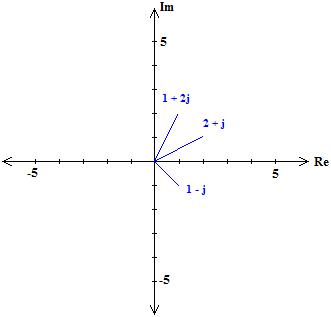Complex numbers needn't be so complex. A complex number is simply a single expression that contains both a real and an imaginary part. To review, the imaginary number j (i is also commonly used) is defined as the square root of negative one. Of course, the square root of negative one isn't easy to visualize, but, as it turns out, imaginary numbers are a powerful and have many applications in the real world. Electrical power, for example, has an imaginary part in a system containing inductance and/or capacitance. This is known as complex power, an example of a complex number. Here are more examples:
$ 1 + 2j $
$ 2 + j $
$ 1 - j $
$ a + bj $
As mentioned earlier, each complex number can be broken down into a real and an imaginary part as follows:
$ Re[1 + 2j] = 1 $
$ Im[1 + 2j] = 2 $
$ Re[2 + j] = 2 $
$ Im[2 + j] = 1 $
$ Re[1 - j] = 1 $
$ Im[1 - j] = -1 $
$ Re[a + bj] = a $
$ Im[a + bj] = b $
Of particular interest is finding the magnitude (aka norm) of the complex number. To do this it is necessary to visualize complex numbers. We begin by using a coordinate system with a real horizontal axis and an imaginary vertical axis. Each imaginary number can be visualized as a vector as follows:
The magnitude can be found in the same way that it is found for a vector. In general:
$ |a + bj| = \sqrt{a^2 + b^2} $
Examples:
$ |1 + 2j| = \sqrt{1^2 + 2^2} = \sqrt{5} $
$ |2 + j| = \sqrt{2^2 + 1^2} = \sqrt{5} $
$ |1 - j| = \sqrt{1^2 + (-1)^2} = \sqrt{2} $


